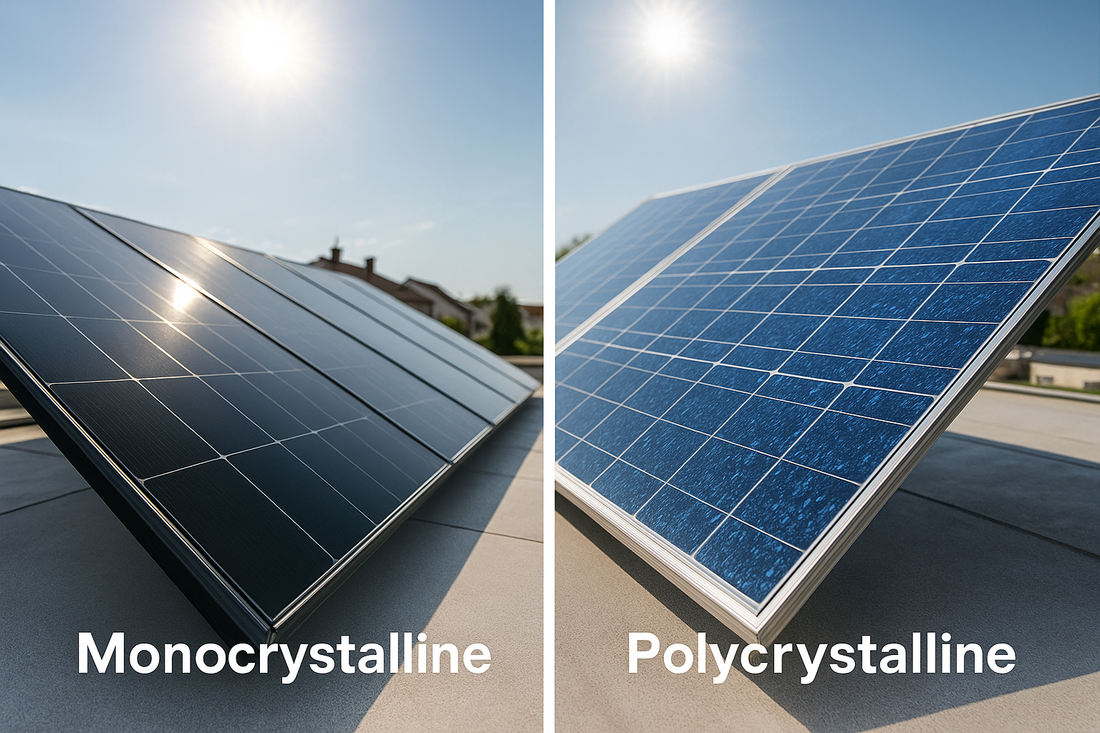
Battle of the Panels: Monocrystalline vs Polycrystalline – The Truth About Efficiency & Cost
Share
Monocrystalline vs Polycrystalline: Which Solar Panel Is Right for Your Home or Business?
In the evolving world of renewable energy, the choice between monocrystalline and polycrystalline solar panels often stirs significant debate among homeowners and commercial solar panel users alike. Both types of solar panels serve as the backbone of solar power systems, converting sunlight into usable electric energy. As the demand for sustainable energy solutions grows, understanding the nuances of these solar panel types becomes crucial for making informed decisions. This article delves into the efficiency and cost differences between monocrystalline and polycrystalline panels, providing a comprehensive overview to guide your solar energy investments.
Understanding Solar Panels
What is a Solar Panel?
A solar panel, fundamentally, is the essential component of any solar system, designed to harness solar energy and convert it into electrical energy. Acting as the backbone of solar power systems, these panels work by using solar cells, typically made from silicon, to capture sunlight. The solar cells then initiate a complex process, creating an electric field that generates power. This transformation is pivotal in the journey from sunlight to electricity, making solar panels a critical element in the quest for renewable energy sources. With various panel types available, the efficiency and design of these systems continue to evolve.
Types of Solar Panels
There are several kinds of solar panels, each differing in design and efficiency. The three primary types of solar panels are monocrystalline, polycrystalline, and bifacial. Traditional solar panels, such as monocrystalline and polycrystalline, are well-known for their wide application in residential solar panels and commercial solar installations.
| Type | Characteristics |
|---|---|
| Monocrystalline Panels | Made from a single crystal of silicon, boasting higher efficiency. |
| Polycrystalline Panels | Constructed from multiple silicon crystals, offering a less efficient yet cost-effective solution. |
In recent times, bifacial modules have emerged, utilizing advanced technology to maximize efficiency by capturing sunlight from both sides.
How Solar Panels Work
The operation of solar panels, particularly monocrystalline solar panels, involves capturing sunlight through their silicon solar cells. These cells absorb solar energy and initiate a series of processes that lead to the creation of an electric field. This electric field, characterized by voltage and current, is essential for generating solar power. The power output of monocrystalline cells tends to be higher due to their higher efficiency and superior temperature coefficient compared to polycrystalline panels. As these panels work to convert sunlight into electricity, they provide a sustainable energy solution that is increasingly important in today's energy-conscious world.
Monocrystalline Solar Panels
Characteristics of Monocrystalline Panels
Monocrystalline solar panels are renowned for their distinctive characteristics, setting them apart from other panel types. These panels are crafted from a single crystal of silicon, making them highly pure and efficient. The dark black color and cut edges of monocrystalline panels make them easily identifiable among various solar panel types.
| Feature | Details |
|---|---|
| Cell Structure | Each panel generally consists of either 60 or 72 solar cells, each containing a silicon crystal. |
| Cost | Comes with a slightly higher cost per watt, as noted by the Lawrence Berkeley National Laboratory. |
These mono panels are prized for their aesthetic appeal and superior efficiency in converting solar energy into electricity.
Efficiency and Performance
The efficiency and performance of monocrystalline solar panels are often the focal points in discussions about solar power systems. These panels are known for their higher efficiency compared to polycrystalline panels, largely due to the use of single crystal silicon. However, despite their remarkable efficiency, monocrystalline panels can be less tolerant to heat. In contrast, polycrystalline panels, although slightly less efficient with an efficiency range of 15-17%, offer consistent performance across varying lighting conditions. This makes polycrystalline panels an appealing option for homeowners looking for cost-effective solutions. Monocrystalline panels, however, excel in maximizing power output under optimal conditions, making them a preferred choice for premium solar installations where efficiency is paramount.
Cost Analysis of Monocrystalline Panels
When analyzing the cost of monocrystalline panels, it is essential to consider their price per watt, which is generally higher than that of polycrystalline panels. This higher initial investment is often justified by the superior efficiency and longer lifespan of monocrystalline panels. Consequently, while the upfront cost is more substantial, many homeowners and commercial solar users find the long-term benefits and energy savings to be worthwhile. The decision between monocrystalline and polycrystalline panels thus hinges on balancing immediate budget constraints against prospective efficiency gains and energy savings over time.
| Type of Panel | Average Cost per Watt (Rs.) |
|---|---|
| Monocrystalline | 24 |
| Polycrystalline | 22 |
Polycrystalline Solar Panels
Characteristics of Polycrystalline Panels
Polycrystalline solar panels, often referred to as multi-crystalline or many-crystal silicon panels, are a common type of solar panel used in both residential and commercial applications. These panels are constructed by melting multiple silicon crystals together to form the solar cells, resulting in a distinctive blue hue. Unlike monocrystalline panels, where the silicon is a single crystal, the polycrystalline panels have a rugged surface and square-shaped cells, uncut at the edges. The lower purity of the silicon ingots used in polycrystalline solar panels contributes to their lower efficiency, yet they remain a popular choice due to their cost-effectiveness and ease of production.
Efficiency and Performance
In terms of efficiency and performance, polycrystalline panels are generally considered less efficient than their monocrystalline counterparts. The multiple silicon crystals within each solar cell contribute to a slightly lower efficiency, typically ranging from 15% to 17%. However, the polycrystalline panels can perform consistently across varying light conditions, which can be beneficial in certain environments. While their power output is not as high as monocrystalline panels, polycrystalline solar panels are known for their durability and ability to withstand higher temperatures without significant performance degradation. This makes them a reliable choice for many homeowners and commercial solar systems looking for a balance between efficiency and cost.
Cost Analysis of Polycrystalline Panels
Polycrystalline solar panels are often favored for their affordability, being cheaper than monocrystalline panels by 10-20%. As reported by EnergySage, the average cost of polycrystalline panels is around $2.50 to $3 per watt as of 2018, compared to over $3 per watt for monocrystalline options. This cost-effectiveness makes them an attractive option for both residential and commercial users, particularly for those with budget constraints. The lower production costs of polycrystalline panels translate into significant savings for customers, especially in large-scale installations. For commercial and utility-scale projects, choosing polycrystalline panels could result in tens of thousands of dollars in savings, making them a standard choice for cost-conscious solar energy investments.
Monocrystalline vs Polycrystalline: A Comparative Analysis
Efficiency Comparison
When assessing the efficiency of solar panels, the choice between monocrystalline and polycrystalline options is pivotal. Monocrystalline panels, crafted from a single crystal of silicon, boast over 20% efficiency, making them the superior choice for those prioritizing high power output. This higher efficiency is linked to their advanced temperature coefficient, allowing monocrystalline panels to maintain exceptional performance even in warm climates. Conversely, polycrystalline solar panels, while less efficient, offer an efficiency range of 15-17%. Despite their lower efficiency, polycrystalline panels remain a viable option for many due to their consistent performance across various light conditions.
Cost Comparison
Cost is a significant factor when choosing between monocrystalline and polycrystalline solar panels. Polycrystalline panels are notably cheaper than their monocrystalline counterparts, making them an appealing option for budget-conscious homeowners and commercial solar projects. The upfront cost of monocrystalline panels is higher due to their superior efficiency and the complex manufacturing process involved in producing single crystal silicon cells. However, the long-term energy savings associated with monocrystalline panels can offset the initial investment. Ultimately, the choice hinges on whether the priority is immediate cost savings or long-term efficiency and performance gains.
Which Solar Panel is Better for You?
Deciding between monocrystalline and polycrystalline solar panels involves weighing the pros and cons of each type. Monocrystalline panels offer higher efficiency and a sleek appearance, making them ideal for those with limited space or aesthetic considerations. Polycrystalline panels, while less efficient, are more affordable and provide a solid performance in diverse environmental conditions. The choice between these types of solar panels should consider factors such as budget, available installation space, and specific energy needs. Both monocrystalline and polycrystalline panels have their merits, and the decision ultimately depends on individual priorities and circumstances.
Conclusion
Final Thoughts on Solar Panel Choices
The decision to select either monocrystalline or polycrystalline solar panels largely depends on personal preferences, available space, and financial considerations. Monocrystalline panels, with their higher efficiency and sleek design, are ideal for those seeking maximum power output and aesthetic appeal. In contrast, polycrystalline panels offer a cost-effective solution, balancing affordability with reliable performance. Understanding these variances is crucial in making an informed choice that aligns with both your energy requirements and budget constraints. As the solar industry evolves, these traditional solar panels continue to play an essential role in the push towards sustainable energy solutions.
Future Trends in Solar Technology
As the solar industry advances, new trends are emerging that promise to enhance the efficiency and affordability of solar technology further. Innovations such as bifacial modules, which capture sunlight on both sides, and the development of higher-efficiency silicon cells are leading the way. These advancements aim to maximize the potential of solar energy systems, providing even greater returns on investment for homeowners and commercial users alike. The continuous evolution of solar technology is set to make solar power an increasingly attractive and viable option for global energy needs.
Making an Informed Decision
When choosing between monocrystalline and polycrystalline panels, it is vital to consider the specific features and benefits each offers. Assessing the efficiency, cost, and performance of these solar panel types can guide you towards the best choice for your solar power system. Take time to evaluate the pros and cons of each option, considering factors such as installation space and long-term energy goals. By doing so, you will ensure that your investment in solar technology is well-informed and aligned with your energy needs, resulting in a sustainable and efficient solar power solution.
